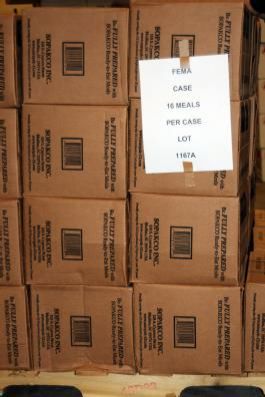Hurricane Sandy Recovery: Ready-To-Eat Meals Have Military Background

While the lights are coming back on in the Northeast after Hurricane Sandy's passing, there are still hundreds of thousands of people in the region without power, and some in more dire straits: cold, destitute and hungry. While charities and volunteers are turning out plenty of hot meals for Hurricane Sandy victims, more durable rations are also in abundance.
Hundreds of thousands of ready-to-eat meals have already been handed out to Hurricane Sandy victims by the American Red Cross and the Federal Emergency Management Agency (FEMA).
The story of the ready-to-eat meal is common in American science: ingenuity sparked by military need and later translated for civilians.
Soldiers' rations in the U.S. have come a long way from hard tack and beef. After the Revolutionary War, the military moved towards more canned food, but this proved cumbersome and heavy. In World War I, American doughboys snacked on preserved meats that were easier to carry. In World War II, the military branched out into specialized meals, offering Mountain rations more suitable for high altitudes and Jungle rations in waterproof bags.
During the Vietnam War, there was return to canned wet rations, but there was still a gap in getting troops the nutrition they needed. So, in the early 1960s, the U.S. Department of Defense began developing dehydrated meals stored in plastic pouches that would evolve into the modern meal, ready-to-eat, or MRE.
One important innovation in ready-to-eat technology came in 1992, with the water-activated flameless ration heater, a small packet of powdered iron, magnesium and table salt. When water is added, the oxidizing reaction produces magnesium hydroxide and heat. The salt and iron particles are in the mix to speed up the reaction so that the water quickly reaches a boil, enabling a soldier to have a hot meal.
Nowadays, MREs come in 24 different varieties, with kosher, halal, and vegetarian options available. They have a shelf life of about three years, under most storage conditions, and can withstand parachute drops from 1,250 feet.
FEMA and Red Cross ready-to-eat meals are similar, but not identical to, MREs.
One of the biggest difference between civilian and military MREs is calories. Active servicemembers can burn around 4,200 calories a day while they're on duty, more than twice the daily recommended caloric intake for most civilians that aren't running ultramarathons. A typical single military-grade MRE contains around 1,200 calories, much more than the Red Cross and FEMA meals. The First Strike Ration, developed for periods of intense combat, is a whopping 2900 calories. Civilian MREs have fewer calories and less sodium.
But how do they taste? While they certainly won't compare with some of the finer fare at many New York restaurants, most reviews rate the ready-to-eat meals as fairly palatable.
Ally Kist, a nurse volunteering at a New Jersey shelter during the brunt of Sandy's fury, told NPR that she was partial to a FEMA meal with buffalo chicken and sides of crackers, peanut butter, cheese and coffee.
But she "learned the hard way that the only ones worth eating were the chicken ones and the vegetable ones," Kist told NPR's The Salt.
© Copyright IBTimes 2024. All rights reserved.





















